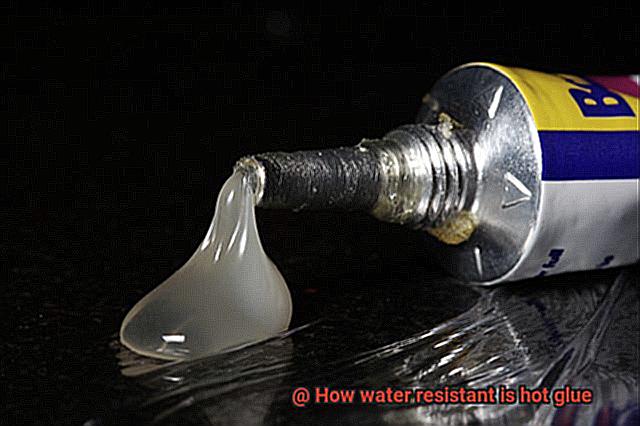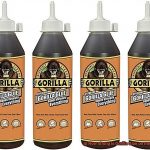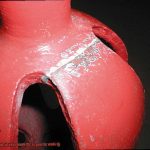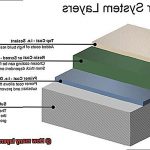Are you tired of throwing away your favorite pair of shoes just because the sole has come off? Fear not, shoe glue is here to save the day. But how well does it actually work?
As a shoe enthusiast myself, I know how frustrating it can be to have to retire a perfectly good pair of shoes due to a minor repair issue. That’s why I’ve done my research and put together this blog post to answer all your burning questions about shoe glue.
- Shoe glue is no ordinary adhesive – it’s specifically designed for the purpose of repairing shoes. Its unique blend of chemicals makes it durable, flexible, and waterproof, ensuring a long-lasting bond between the sole and the shoe.
- But let’s get down to business – how effective is shoe glue really? We’ll explore the science behind its bonding abilities and discuss its advantages and disadvantages. And if you’re wondering when it’s best to use shoe glue versus other adhesives, we’ve got you covered there too.
Whether you’re a DIY enthusiast or just looking for a cost-effective way to repair your shoes, this blog post is perfect for you. So buckle up and get ready to dive into the fascinating world of shoe glue.
What Is Shoe Glue?
Contents
Shoe glue is the ultimate solution for repairing your footwear and extending its lifespan. It’s a specially designed adhesive made up of a combination of synthetic chemicals and natural rubber, formulated to bond strongly with the materials commonly used in shoes like leather, rubber, fabric, and synthetics.
One of the most critical factors to consider when using shoe glue is selecting the right type for your shoe material. Using the wrong type of glue could weaken the bond or even damage your beloved shoes. Therefore, it’s crucial to choose a high-quality glue that is specifically designed for your shoe material.
Shoe glue comes in various forms such as liquid, gel, and paste, each with its unique properties suitable for different types of shoe repairs. If you need to make a quick fix, liquid shoe glue is perfect for attaching soles and heels. However, if you want to fill gaps and holes, paste shoe glue is thicker and better suited for this purpose.
Application is also key when using shoe glue. Preparing the surfaces to be bonded correctly, precise application, and sufficient drying time are essential for the best results. Carelessness in any of these steps may lead to weak bonds or even complete failure of the repair.
Shoe glue is known for its strong bonding abilities that can withstand daily wear and tear, creating a permanent bond between two surfaces. It’s easy to use, dries quickly – usually within a few minutes – allowing you to wear your repaired shoes almost immediately.
Factors That Affect How Well Shoe Glue Works
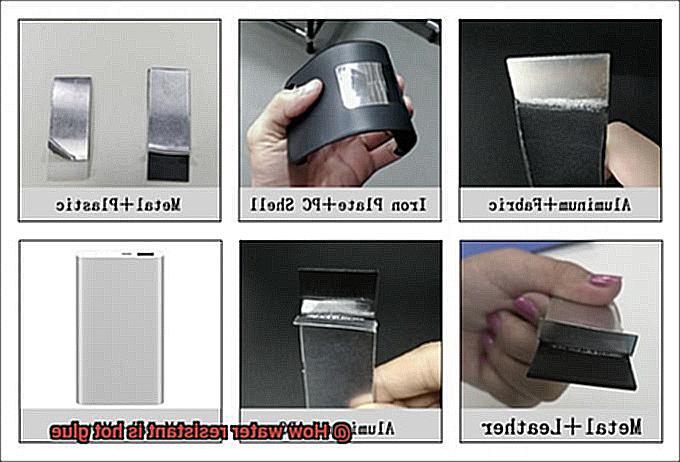
Shoe glue can save the day. But before you get started, it’s essential to understand what factors can affect how well shoe glue works.
The type of glue used is critical. Different adhesives have different properties, such as viscosity, setting time, and bonding strength. While it may be tempting to use superglue for everything, it may not work well on soft materials like fabric or rubber. Hence, ensure that you select the right adhesive that matches the material you are working with.
The material being glued is another crucial factor that affects how well shoe glue works. Leather shoes require different adhesives than canvas or rubber shoes. Knowing the properties of the materials being glued can help you make informed decisions while selecting the right adhesive.
Environmental conditions during application can also affect how well shoe glue works. Temperature and humidity levels can impact bonding strength and setting time of the adhesive.
High temperatures and humidity can accelerate drying but may result in weaker bonds, while low temperatures and humidity can slow down drying and affect bonding strength.
So pay attention to the weather conditions when gluing.
The Different Types of Shoe Glue
Shoes are a vital part of our daily lives, but they can wear out quickly, especially if used regularly. Fortunately, shoe glue is an excellent way to extend the life of your favorite shoes and save money in the long run.
However, with so many different types of shoe glue available in the market, choosing the right one for your needs can be overwhelming. In this article, we will delve into the various types of shoe glue available and their respective advantages and disadvantages to help you make an informed decision.
Super Glue
If you need a quick fix for your shoes, super glue is a popular option. It dries quickly and creates a strong bond that can last for a while. However, it can be brittle and may not work well on certain materials, such as rubber or vinyl.
Epoxy
Epoxy is a two-part adhesive that creates a strong bond that can withstand heavy use. It is often used in industrial settings and can be useful for repairing shoes that undergo constant wear and tear. However, it can take longer to dry than other types of glue.
Polyurethane
For those looking for a more flexible option, polyurethane glue may be the way to go. This type of glue can provide a strong bond while also allowing for some flexibility in the shoe. It is ideal for repairing shoes made of materials that require some give, such as rubber or leather.
Contact Cement
Contact cement is a popular option among shoemakers and repair shops because it creates a permanent bond that is resistant to water and heat. However, it requires both surfaces to be coated and allowed to dry before being pressed together. It is ideal for use on materials like rubber, leather, and vinyl.
Shoe Goo
Shoe goo is a versatile adhesive that can be used for repairing soles and heels, as well as sealing up holes in the upper part of the shoe. One of its benefits is that it remains flexible after it dries, which can help prevent further damage to the shoe. It is ideal for use on a variety of materials.
Preparing the Surface for Bonding
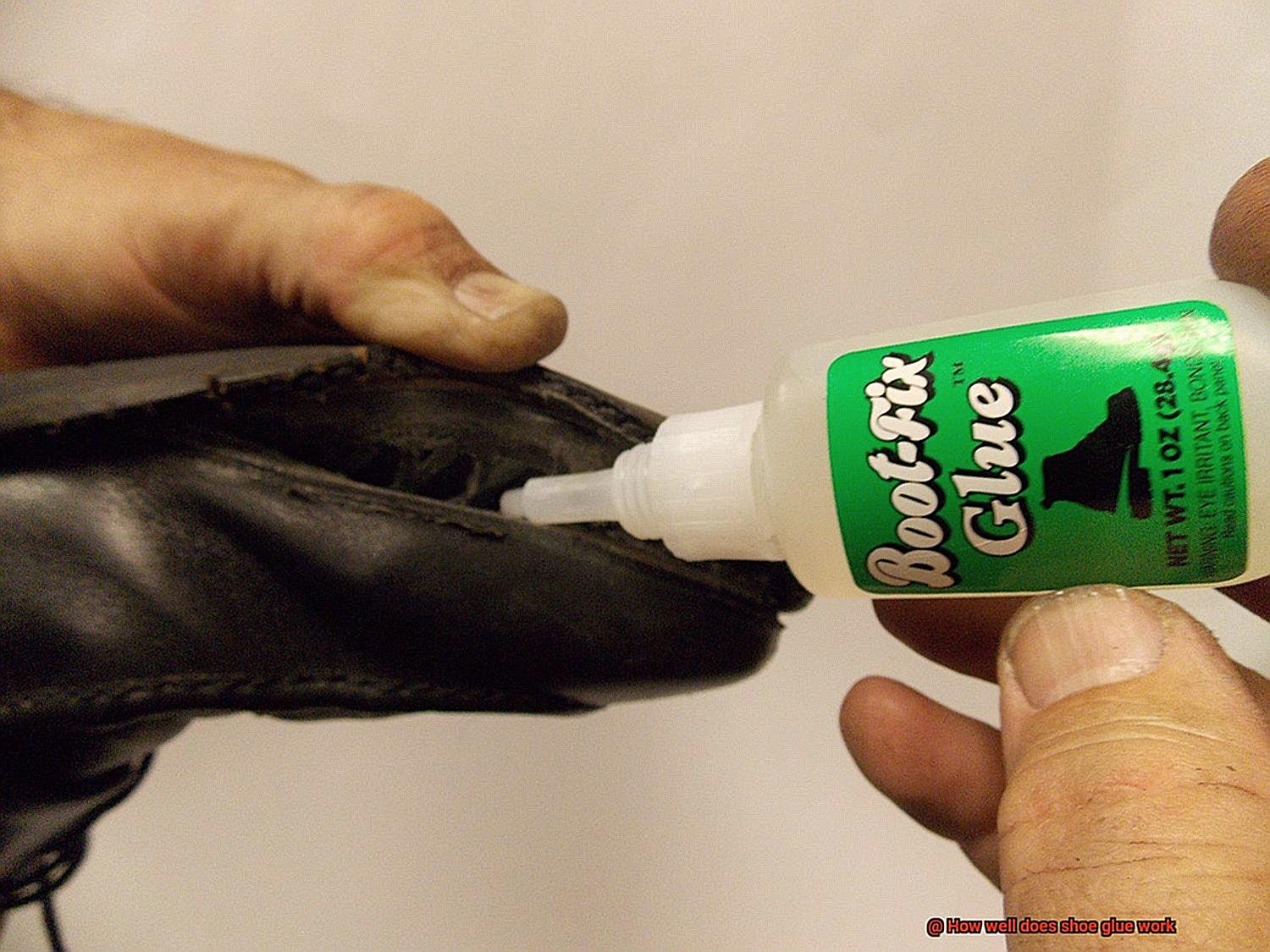
Then it’s time to learn about the crucial process of preparing the surface for bonding.
The first step in preparing the surface for bonding is to ensure that it is completely clean and free from any dirt, dust, or contaminants. A quick wipe with a clean cloth or a specialized shoe cleaning agent can do wonders in removing any grime or residue.
But that’s not all. To achieve a strong and lasting bond between different shoe materials, you also need to roughen up the surface. This can be done by using sandpaper or a wire brush to create a rough texture that provides better adhesion for your shoe glue.
It’s important to note that different materials may require different preparation methods. For example, leather surfaces may need conditioning with a specialized leather conditioner to make them more pliable and receptive to the glue. On the other hand, rubber surfaces may require the use of a primer or an adhesion promoter to improve their bonding capability.
Applying Shoe Glue Correctly
Shoe glue could be your savior. But how can you apply shoe glue correctly to ensure your repair job lasts as long as possible?
It all starts with preparation. The surface you’ll be gluing needs to be clean and free of any debris or dust. A specialized cleaning agent or a clean cloth can help you achieve this. Additionally, roughening up the surface using sandpaper or a wire brush will create a sturdy texture that will provide better adhesion for the glue.
Once your surface is prepped, it’s time to apply the glue. Be careful and apply it evenly, making sure to cover the entire surface area that needs to be bonded. Depending on the type of glue you’re using, you may need to apply it in multiple layers or wait a certain amount of time before pressing the surfaces together.
One crucial aspect to consider when applying shoe glue is the amount of glue being used. Too little, and it won’t hold; too much, and it will overflow and create a mess. A thin layer of glue applied evenly should do the trick.
Patience is key when letting the glue dry. Don’t rush it. Give it enough time to dry completely before wearing or using your shoes again. This will ensure that the bond is as strong as possible and that your repair job will last as long as possible.
To recap, here are the steps to applying shoe glue correctly:
- Clean and prep the surface for gluing
- Apply the glue carefully and evenly, covering the entire surface area
- Use the correct amount of glue – not too little, not too much
- Allow sufficient drying time before wearing or using your shoes again
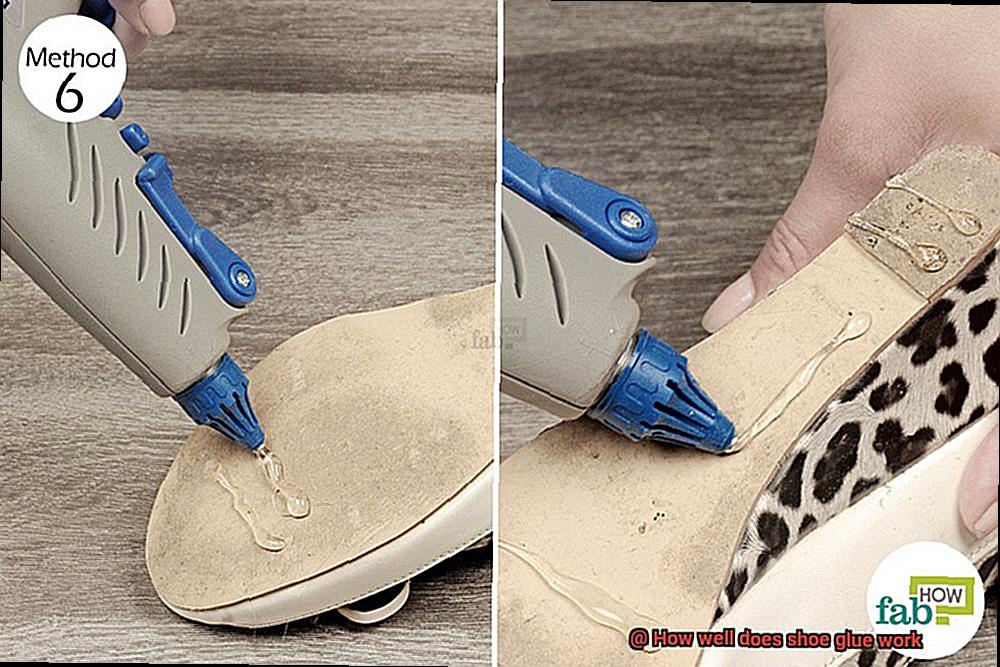
Drying Time and Curing Process
When it comes to fixing up your beloved pair of shoes with some shoe glue, it’s essential to understand the drying time and curing process. After all, nobody wants their shoes to fall apart shortly after a repair job.
Firstly, it’s crucial to select the right type of glue for your particular repair job. Some adhesives are made for temporary fixes, while others are meant for permanent repairs. The curing time and drying process will vary depending on the type of glue you choose.
Temperature and humidity play a significant role in how long it takes for shoe glue to dry and cure. Warm, dry environments facilitate faster drying times, while cooler, humid spaces can slow down the process. Therefore, it’s crucial to factor in the environment when planning your repair project.
Following the manufacturer’s instructions is critical in ensuring a successful repair job. Waiting for a specific amount of time before adding any pressure or weight to the repaired area may be necessary. Additionally, avoiding exposure to water or other elements until the glue has fully cured is essential.
Patience is key when working with shoe glue. While some adhesives dry quickly, others may take several hours or even days to fully cure. Rushing the process can lead to subpar results, so take your time and allow the glue to fully dry and cure before wearing your repaired shoes.
Lastly, here are some tips to help you achieve a successful repair job:
- Choose the right type of glue for your repair job
- Take into account the temperature and humidity of your environment
- Follow the manufacturer’s instructions carefully
- Exercise patience and allow ample time for the glue to dry and cure
Benefits of Using Shoe Glue
As an expert in shoe repair, I highly recommend adding this versatile adhesive to your shoe repair kit.
First and foremost, using shoe glue can save you money. Instead of buying a new pair every time there’s a small tear or damage, a little bit of shoe glue can go a long way in repairing the damage. This is especially useful for expensive shoes that you want to keep for a long time.
Moreover, shoe glue is incredibly durable. It can withstand daily wear and tear, making it perfect for those who lead an active lifestyle. Walking or running – shoe glue is designed to handle the pressure and stress that comes with it, ensuring your shoes hold up for longer.
One of the best things about shoe glue is how quickly it dries. No more waiting for days to wear your favorite pair of shoes again. Shoe glue dries quickly, enabling you to fix your shoes in no time, making it ideal for those who lead busy lives.
Shoe glue is also versatile and can be used on a variety of materials such as leather, rubber, and synthetic fabrics. It’s an all-in-one solution for all types of shoes – whether you need to fix leather boots or canvas sneakers, shoe glue can do the job.
Lastly, many shoe glues are waterproof, making them resistant to water and moisture. This is particularly important if you live in a rainy or humid climate where your shoes are likely to get wet. The waterproof nature of shoe glue ensures your shoes remain intact and prevents further damage due to water exposure.
Potential Issues With Using Shoe Glue
While it may seem like a quick fix, there are important factors to consider before attempting any DIY repairs.
First and foremost, not all shoe glue products are created equal. It’s essential to choose the right product for the job as some may work better on certain materials than others. Research and read reviews before making a purchase to ensure you have the best product for your needs.
One of the most significant potential issues is that shoe glue may not always provide a permanent solution. While it can temporarily fix a shoe, it may not hold up over time and could require reapplication or a more permanent repair. Therefore, if you’re looking for a long-term solution, shoe glue may not always be the answer.
Moreover, shoe glue may not be suitable for all types of shoes or repairs. For example, if the sole of a shoe has completely detached from the upper, using shoe glue alone may not be strong enough to reattach it. In this case, it’s best to seek out professional help from a cobbler or repair service.
It’s crucial to use shoe glue in a well-ventilated area and follow the manufacturer’s instructions carefully. Some types of shoe glue can emit strong fumes that can be harmful if inhaled. Therefore, it’s essential to use them only in well-ventilated areas or with a respirator mask.
Lastly, using shoe glue can sometimes make it difficult or impossible to perform future repairs on the same area. The glue can create a strong bond that is challenging to break without causing further damage to the shoe. Thus, it’s worth considering alternative solutions when possible.
JAaIZa3pZMc” >
Conclusion
In summary, shoe glue is a reliable and effective solution for repairing shoes and prolonging their lifespan. Its unique blend of synthetic chemicals and natural rubber creates a waterproof, flexible, and long-lasting bond between the sole and the shoe. However, it’s essential to choose the right type of adhesive for your specific repair job as different products have varying properties such as viscosity, setting time, and bonding strength.
To achieve a strong bond, preparing the surface correctly by thoroughly cleaning it and roughening it up with sandpaper or a wire brush is crucial. Applying the glue evenly and allowing sufficient drying time before wearing or using your shoes again will ensure that the bond is as robust as possible.
Shoe glue offers several benefits such as saving you money by avoiding buying new shoes every time there’s minor damage. It’s incredibly durable, versatile, quick-drying, and waterproof. However, not all shoe glue products are created equal; some may not provide a permanent solution or may be unsuitable for certain types of shoes or repairs.
Overall, with proper preparation and application techniques, shoe glue can be an affordable way to extend the life of your favorite pair of shoes while reducing waste in landfills.

